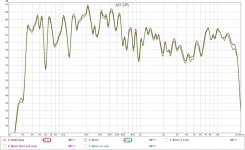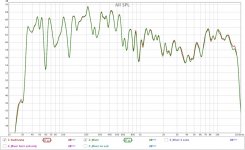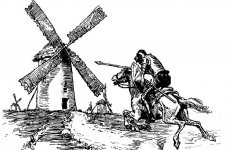I must admit my attention has been towards the waves we were supposed to get with a typhoon outside in the ocean around us... it didn't really happen, so I turned back and went inside for some measurements.
Here is the difference when playing a sweep on either Audirvana or JRiver, using the same Mac mini as the source, and another Mac for the recording. I'm using the "time-reference" to get the frequency response, but it messes up the impulse badly.
This test doesn't show the differences between the Mac drivers and the PC Asio drivers. That will be for another day, I simply didn't have time to do it all today.
So, here are the 2 sweeps, superposed. Nothing has changed besides the apps on the same Mac mini. DAC used as a pre was set and not touched between sweeps, no processing of any kind on either Audirvana and JRiver... no EQ... nothing.
First sweep shows Audirvana is louder by 0.4dB.
Adjusted in the second graph. There are still minute differences... not much though.
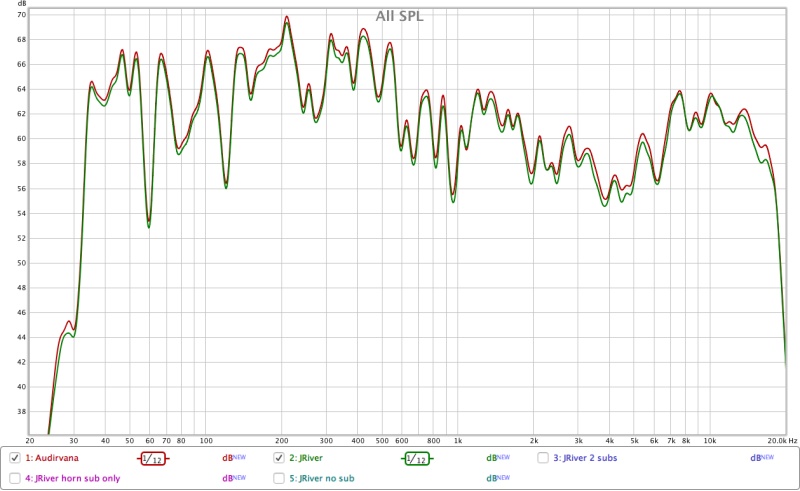
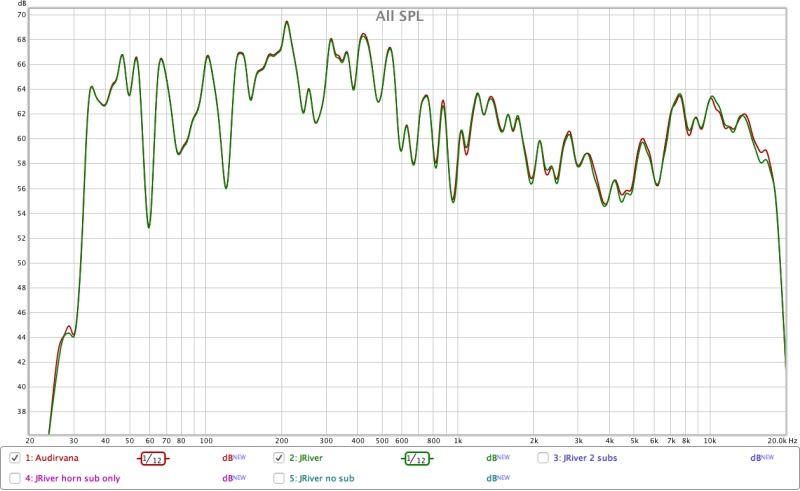
Here is the difference when playing a sweep on either Audirvana or JRiver, using the same Mac mini as the source, and another Mac for the recording. I'm using the "time-reference" to get the frequency response, but it messes up the impulse badly.
This test doesn't show the differences between the Mac drivers and the PC Asio drivers. That will be for another day, I simply didn't have time to do it all today.
So, here are the 2 sweeps, superposed. Nothing has changed besides the apps on the same Mac mini. DAC used as a pre was set and not touched between sweeps, no processing of any kind on either Audirvana and JRiver... no EQ... nothing.
First sweep shows Audirvana is louder by 0.4dB.
Adjusted in the second graph. There are still minute differences... not much though.
Attachments
First sweep shows Audirvana is louder by 0.4dB.
Adjusted in the second graph. There are still minute differences... not much though.
Did the two systems still sound different to you as you had shared earlier?
Last edited:
Perceval, the way I did it was to play a file of a dirac pulse in the audio program and record the output in Audacity on the same computer using the same interface. Using different clocks for ADC and DAC will always have some influence on the impulse. If you run more than one sweep do they give you the exact same response when smoothed? Just to rule out the difference between sweeps if there was any noise contamination.
Just to muddy the waters further I actually heard a difference between the ASIO driver and the WASAPI driver in Jriver when using an Amanero. The Amanero doesn't have an ASIO control panel to adjust the buffers separately to Jriver, this is the first time I have ever noticed a difference.
Just to muddy the waters further I actually heard a difference between the ASIO driver and the WASAPI driver in Jriver when using an Amanero. The Amanero doesn't have an ASIO control panel to adjust the buffers separately to Jriver, this is the first time I have ever noticed a difference.
Couldn't really tell a difference because both measurements were using the same Mac audio drivers.
I was more concerned with the differences between my Mac and my PC.
The impulse is all garbled because I am using two different computers. It works fine for the FR, but impulse has never worked for me when using a timing reference.
Fluid, did you use SoundFlower to reroute the audio to Audacity?
I was more concerned with the differences between my Mac and my PC.
The impulse is all garbled because I am using two different computers. It works fine for the FR, but impulse has never worked for me when using a timing reference.
Fluid, did you use SoundFlower to reroute the audio to Audacity?
No I used a physical loopback cable, set the soundcard as output in Audivarna or Jriver and set same card as the input in Audacity. Set Audacity to record press play on Audivarna then trim out the silence. I set the Dirac Pulse on repeat in the player and then cut one out in Audacity. I set the levels of the input gains first by using REW to calibrate as the Dirac pulse is full scale and you don't want it to clip.
By doing it that way rather than measuring a speaker you limit the number of variables down to the computer, program and drivers.
I suppose you could use Soundflower to avoid the cable by setting it as output in player and input in Audacity, I didn't try that because I gave up on Soundflower in this setup because I was trying to use it to get REW looped in but Audivarna doesn't have an input to make that work.
By doing it that way rather than measuring a speaker you limit the number of variables down to the computer, program and drivers.
I suppose you could use Soundflower to avoid the cable by setting it as output in player and input in Audacity, I didn't try that because I gave up on Soundflower in this setup because I was trying to use it to get REW looped in but Audivarna doesn't have an input to make that work.
Last edited:
Taking it slower this time, I setup my Home Theatre settings again with the older saved FIR filters. Still need to optimize here and there but it was working very good as is.
I'll slowly try and get back to where I once was, but I'm not that far off anyway. I'm going to split my ambient chain again as I had just before the crash. That makes it possible to edit the phantom part separately from the ambient part. Much easier to dial it in to taste.
I'll redo much of the post EQ sometime soon, as I believe there's still more to gain there. Subtle changes, not as easy to dial in just right. It always takes up way more time.
I'm also thinking of getting a Jensen transformer as a ground loop isolator for my ambient channels. Right now I just have a cheap € 13,50 ground loop isolator in there that does an average job. In all honesty that second amplifier, the Pioneer A-447 could do with some maintenance too.
Still not ready to try some DIY amplifiers, as the list for what I want will get longer before this journey is over. The sub power is still up for debate too.
If I ever find the time to get busy in the garage. This hasn't been the year for such projects, sadly. At least not up till now. Always running out of time.
I'll slowly try and get back to where I once was, but I'm not that far off anyway. I'm going to split my ambient chain again as I had just before the crash. That makes it possible to edit the phantom part separately from the ambient part. Much easier to dial it in to taste.
I'll redo much of the post EQ sometime soon, as I believe there's still more to gain there. Subtle changes, not as easy to dial in just right. It always takes up way more time.
I'm also thinking of getting a Jensen transformer as a ground loop isolator for my ambient channels. Right now I just have a cheap € 13,50 ground loop isolator in there that does an average job. In all honesty that second amplifier, the Pioneer A-447 could do with some maintenance too.
Still not ready to try some DIY amplifiers, as the list for what I want will get longer before this journey is over. The sub power is still up for debate too.
If I ever find the time to get busy in the garage. This hasn't been the year for such projects, sadly. At least not up till now. Always running out of time.
I had a little more time yesterday to tweak the HT settings.
I played pieces of Lord of the Rings, The Return of the King. I know, I know, I should have played The Two Towers . The Return of the King has more action on the battle field, with drums, big collisions, big stones dropping and the screams from the Fellbeast.
. The Return of the King has more action on the battle field, with drums, big collisions, big stones dropping and the screams from the Fellbeast.

All in all very entertaining and really coming to live again with the ambient surrounds. Just a few more tweaks and I can call it done. Home Theatre asks for slightly different tweaks in the mid/side EQ as it is mixed for a real center channel, opposed to regular stereo mixes. I also think I might have to remove some of the 200-300 Hz warmth I like so much in stereo for more realism in spoken voices. These are tiny differences that overall can do a lot for perception.
The bass in this older RePhase assisted FIR filter is much better than my new attempt (based on the averages). It's the same filter that was used in the correction I lost in the PC crash. It was the little EQ tweaks that got lost and exercises like these should get me back on track.
I played pieces of Lord of the Rings, The Return of the King. I know, I know, I should have played The Two Towers
All in all very entertaining and really coming to live again with the ambient surrounds. Just a few more tweaks and I can call it done. Home Theatre asks for slightly different tweaks in the mid/side EQ as it is mixed for a real center channel, opposed to regular stereo mixes. I also think I might have to remove some of the 200-300 Hz warmth I like so much in stereo for more realism in spoken voices. These are tiny differences that overall can do a lot for perception.
The bass in this older RePhase assisted FIR filter is much better than my new attempt (based on the averages). It's the same filter that was used in the correction I lost in the PC crash. It was the little EQ tweaks that got lost and exercises like these should get me back on track.
Attachments
Last edited:
Mid/Side EQ uncovered
http://www.diyaudio.com/forums/full-range/303417-range-tc9-line-array-cnc-cabinet-79.html#post5189628
While I mentioned it a lot, and have shown a couple of values on this thread I don't believe I've ever written it down this clear. Well except in an email to fluid. Anyway, this part was always buried deep into a maze of EQ. When I started over a couple of weeks ago I figured it would be smart to have it separate from the rest of the EQ scheme. That's when I uncovered these settings and numbers and send them to fluid. Take them as a guide, as room + setup (and even head size, yes, your head ) can influence it's effect. These are supposed to be all linear phase EQ for best results. Well, just read the post in the link I supplied if interested.
) can influence it's effect. These are supposed to be all linear phase EQ for best results. Well, just read the post in the link I supplied if interested.
Probably best to discuss it there, so this is just a heads up.
http://www.diyaudio.com/forums/full-range/303417-range-tc9-line-array-cnc-cabinet-79.html#post5189628
Mid Channel
100Hz Q 0.5 Gain 0.5
600Hz Q 0.5 Gain -3.0
1550Hz Q 1.5 Gain 2.0
3000Hz Q 3.5 Gain -1.0
3700Hz Q 2.7 Gain -2.0
5500Hz Q 4.0 Gain 1.0
7200Hz Q 3.0 Gain -1.5
High Shelf 2470Hz Q 0.5 Gain 0.8
Side Channel
Low Shelf 80Hz Q 0.70 Gain -0,5
A general boosts of the sides by 0.5dB
While I mentioned it a lot, and have shown a couple of values on this thread I don't believe I've ever written it down this clear. Well except in an email to fluid. Anyway, this part was always buried deep into a maze of EQ. When I started over a couple of weeks ago I figured it would be smart to have it separate from the rest of the EQ scheme. That's when I uncovered these settings and numbers and send them to fluid. Take them as a guide, as room + setup (and even head size, yes, your head
Probably best to discuss it there, so this is just a heads up.
I hope I didn't post something that you only meant to share privately 
I thought you had posted the numbers before as I remember them being quite familiar when you sent them through.
Your thread has become quite long so finding anything now does take a bit of digging, probably even for you!
That table was pretty much a cut and paste from the email as I wanted it to be accurate and credit you as the source. I should have asked first, sorry about that.
While it has been talked about in this thread I don't know how many people have tried it. All I can say is if you have the ability to test it try it, I waited quite a while as I wasn't convinced it would make much of a difference. I was wrong, and I don't think that this is array specific I imagine it would work well on most systems.
The exact figures might not be set in stone but they work very well for me so far.
I thought you had posted the numbers before as I remember them being quite familiar when you sent them through.
Your thread has become quite long so finding anything now does take a bit of digging, probably even for you!
That table was pretty much a cut and paste from the email as I wanted it to be accurate and credit you as the source. I should have asked first, sorry about that.
While it has been talked about in this thread I don't know how many people have tried it. All I can say is if you have the ability to test it try it, I waited quite a while as I wasn't convinced it would make much of a difference. I was wrong, and I don't think that this is array specific I imagine it would work well on most systems.
The exact figures might not be set in stone but they work very well for me so far.
Don't worry, no need to be sorry. Quite a while ago I kind off promised on this thread I would post more about it.
I've shared bits and pieces, though the list I send you was the complete thing. It takes the side EQ as a base, as most of the edits happen in the phantom part. This is because the sides usually show a more smooth curve/FR shape compared to the phantom center.
In other words easier to find, target for and implement.
The way I have it in my setup is mixed in with a specific "target" that was somewhere between being right for the phantom center (tonally) and partly right for the sides. That looked just a bit too weird to publish .
.
I do hope more people get to try it now that it's out in the open in a simple form. For those playing music from a digital source it should be a breeze to try it. No gain, no pain... nothing to lose really. Just make sure it's linear phase EQ for this mid/side tweak.
If someone wants to try it for Home Theatre without using a real center, that can be done too. The frequency patterns are largely the same, but you can use bigger gain values here and there. HT is mixed for a real center and can sound very sweet with this trick. Sometimes its even better than material mixed for stereo, as one never knows what that (stereo) was mixed for and/or on. If it sounds good on headphones chances are it will sound good with these EQ tweaks.
It can be amazing how much better (more clarity or whatever you want to call it) the phantom dialog becomes. It will be way easier to separate multiple voices etc. Highly recommended!
I've shared bits and pieces, though the list I send you was the complete thing. It takes the side EQ as a base, as most of the edits happen in the phantom part. This is because the sides usually show a more smooth curve/FR shape compared to the phantom center.
In other words easier to find, target for and implement.
The way I have it in my setup is mixed in with a specific "target" that was somewhere between being right for the phantom center (tonally) and partly right for the sides. That looked just a bit too weird to publish
I do hope more people get to try it now that it's out in the open in a simple form. For those playing music from a digital source it should be a breeze to try it. No gain, no pain... nothing to lose really. Just make sure it's linear phase EQ for this mid/side tweak.
If someone wants to try it for Home Theatre without using a real center, that can be done too. The frequency patterns are largely the same, but you can use bigger gain values here and there. HT is mixed for a real center and can sound very sweet with this trick. Sometimes its even better than material mixed for stereo, as one never knows what that (stereo) was mixed for and/or on. If it sounds good on headphones chances are it will sound good with these EQ tweaks.
It can be amazing how much better (more clarity or whatever you want to call it) the phantom dialog becomes. It will be way easier to separate multiple voices etc. Highly recommended!
Last edited:
Lots of interesting sources in this thread though: Explanation of Time Aligned and Linear-Phase?
Lots of interesting sources in this thread though: Explanation of Time Aligned and Linear-Phase?
Thanks pointing there, btw way did you see first 1/2 of this page that eriksquires poited to over there (BACCH 3D Audio | Digital Room Correction)
Not to talk about same site also show nice way isolate PCIe soundcard from motherboard nasties (Isolation | Digital Room Correction)
Thanks pointing there, btw way did you see first 1/2 of this page that eriksquires poited to over there (BACCH 3D Audio | Digital Room Correction)
I know that page
Not to talk about same site also show nice way isolate PCIe soundcard from motherboard nasties (Isolation | Digital Room Correction)
Now that I did not see, very interesting!
Not to talk about same site also show nice way isolate PCIe soundcard from motherboard nasties (Isolation | Digital Room Correction)
I'm pretty sure he is using a regular extender and not an 'optical' one as there is no active circuitry anywhere on it.. but he has modified it to use linear power supplies instead of the computer supply
I was wondering about that too. I've always wanted to isolate my soundcard from the noisy PC though. I was just about ready to try some Jensen transformers but this just might be a smarter way to do it.
My mains are isolated with the DAC trough optical, but if I want to power my subs I'll get into trouble again.
My mains are isolated with the DAC trough optical, but if I want to power my subs I'll get into trouble again.
- Home
- Loudspeakers
- Full Range
- The making of: The Two Towers (a 25 driver Full Range line array)
